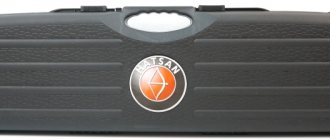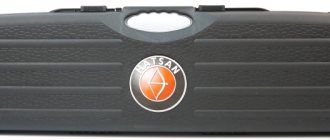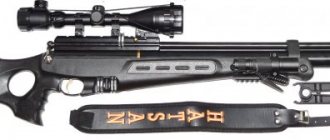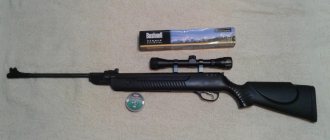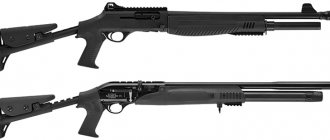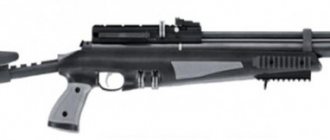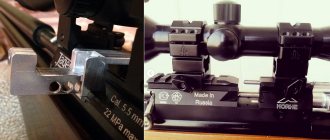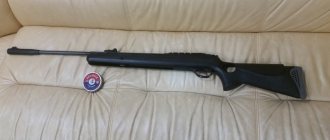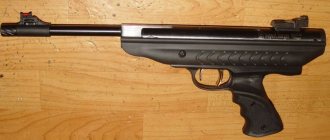Review of the Hatsan 135 SP air rifle
Turkish ]Hatsan pneumatics[/anchor] has expanded its line of magnum-class products with this rifle. Solid, weighty and long-range. The included sight makes it possible to achieve high accuracy, even at a distance of one hundred meters.
Advantages and disadvantages
Pros of the Hatsan 135sp rifle:
- The rifled barrel is made of good quality steel.
- The kit comes with a good scope - 3-9x32.
- Pleasant to the touch and well made buttstock made of walnut wood.
- There is a dense rubber butt pad that softens recoil. For the same purpose, the rifle is equipped with a Shock Absorber System, which extends the life of the sight and the weapon itself.
- Adjustable Quattro Trigger.
- There is a universal dovetail strip.
- Not a very high price.
Disadvantages of the model:
- The gun is quite heavy - more than four kilograms. It's difficult to walk with him for a long time.
- The barrel is not always well processed; the quality of the muzzle chamfer and rifling is also unimportant.
- The plastic piston cuff is not strong enough; it fails quite quickly. Gas etching may occur.
- Heavy (almost 500 grams) piston.
- The optical sight is on rings. This is less convenient than on a candy bar.
Photo of the Hatsan 135 SP air rifle
Application
Having acquired such a weapon, of course, you will not go after a bear and a wild boar. But you can shoot plenty of ducks, hares and partridges with quails. The main thing is to stock up on sufficient quantities of suitable bullets.
They also buy this model for training target shooting - it allows you to improve your skills at long distances. And for entertainment, the rifle can also be useful - it looks decent, shoots powerfully and effectively.
The main pros and cons of the rifle
The main purpose of this rifle is, of course, hunting. And this is where the main negative features emerge. First of all, it is excess power. The barrel is not designed for supersonic bullet speeds, accuracy suffers greatly. Due to the huge amount of air passed through, the sound of the shot is comparable to that of a small-caliber firearm. Also, the huge kinetic energy of “double” recoil will break even a premium-level optical sight, over twenty thousand, in a few shots. All this requires organic fine-tuning, replacing the spring, installing a sound moderator, lightening the piston and many other things that are interesting only to a real airgunner. They will be a burden to the hunter. Again, the weight with the sight will be more than 4.5 kilograms, the weight of the AK-74M is about 3400 grams. Not very suitable for running hunting.
The advantages include just the excess power, which is enough to convert the rifle to 5.5 mm caliber. This is already a serious hunting device, capable of bringing down both a beaver and a wood grouse when it hits the killing points. And reducing the bullet speed by increasing the caliber will lead to stabilization of accuracy. Large weight compensates for recoil (also a minus and a plus). Making the rifle entirely from metal (Gamo, for example, has a polymer barrel coupling, even supermagnums) guarantees reliability and reliability. The potential for designing an autonomous hunting rifle, which, unlike the PCP, allows hunting at subzero temperatures, covers all the existing disadvantages. Problems with the optical sight are solved by replacing the spring with a LPNG (low pressure gas spring) and mounting it on a low monoblock rather than on rings. In addition, domestic manufacturers, for example, the Vologda Optical-Mechanical Plant, produce models of sights designed for installation on air rifles (P4x32 LP).
| Advantages | Flaws |
| The rifle has enormous potential for increasing power and caliber. In foreign markets, Hatsan 135 is even sold in .25 caliber (6.35mm) | Needs fine-tuning, replacing the spring with a less powerful one, installing a sound moderator, etc. |
| Made of weapon grade steel, reliable and trouble-free | Weight with scope over 4.5 kilograms |
| In demand on the secondary market, however, with a significant drop from the store price | It is necessary to carefully select an optical sight and install it on a monoblock mount |
Modifications
Strictly speaking, the one hundred and thirty-fifth model itself is one of the variations of the Hatsan 125 rifle, differing from it in the cuff dimensions, barrel length, stock material and some other details.
The basic version of the Hatsan 135 comes without sights - only a powerful spring and a rubber butt pad are included.
There are also two modifications that differ only in the type of sight:
- Hatsan 135 SP is a model equipped with an Optima 3-9×32 optical sight.
- Hatsan 135 XRD is a model equipped with an Optima 1×40 red dot sight.
In addition, some online stores have now begun to sell Hatsan 135 with a gas spring installed. As an example, we take the Hatsan 135 NITRO model, equipped with a PG-125 type GPU. This spring is made by a company from St. Petersburg, Neva-Target.
arbalet-airgun
Attention. As of 01.07.21, amendments to the Criminal Code of the Russian Federation (Articles 222 and 223) came into force regarding pneumatic weapons with muzzle energy over 7.5 J. If previously liability, and only administrative responsibility, was provided for carrying, transporting and shooting at borders of populated areas, then from now on criminal prosecution with quite serious sanctions is provided for the sale, as well as illegal production, alteration or repair of such samples (see No matter how tight the string is, or New “anti-pneumatic” laws). So, when reading articles written in a completely different era :)), keep in mind the newly discovered circumstances...
"Hatsan-135" is rightfully considered the top model of the largest Turkish arms company, one of the most powerful serial spring-piston rifles. At least, potentially, thanks to the huge 30x120 mm compressor, which made it possible a couple of years ago to release a completely unique BigBore class model for “springs” - the 7.62 mm Hatsan 135 Carnivore. But let’s return to the main character of our story, the classic “One Hundred and Thirty-Fifth”.
First acquaintance with "Hatsan 135"
TTX:
Type: spring-piston pneumatics Charge: single-shot, cocked by breaking the barrel Caliber, mm: 4.5 Bullet speed, m/s: 360 (for some time now, for models with a Vortex gas spring - 380, and the GPs themselves are the same for all line of Khatsan supermagnums, both fractured and with under-barrel cocking - mod. 125, 130, 135, 150 and 155) Type of ammunition: lead bullets Barrel: rifled, steel Barrel length, mm: 450 (by the way, the most popular, mainly due to the price, the Hatsan 125 has a half-meter barrel, which, contrary to myths and legends, does not in any way affect the speed characteristics, unlike a firearm). Total length, mm: 1190 Sights: front sight with fiber-optic threads and aiming rib Safety: yes Stock: wood, “Monte Carlo” Weight, kg: 4.2
"Hatsan mod 135"
It lacks the sophistication of its German classmates, and compared to the Spanish “Hunter” it looks somewhat cumbersome. But in comparison with its younger brother - almost identical in design to the bestseller of the domestic pneumatic market "Hatsan-125" with a classic 29x120 mm compressor (pictured below) - it looks clearly like a rich relative.
Small addition for 2022. Not so long ago, the 130th model (30x120 mm compressor) appeared in the production line of Turkish supermagnums, which in principle is a Hatsan 135 transformed from a luxurious walnut stock into a simple polymer, except perhaps with a barrel shortened to 415 millimeters.
But let's return to the hero of our story. " Hatsan-135" has one undeniable advantage over its polished European colleagues - the price, which is on average half as low. Although, to be honest, I don’t see much point in purchasing high-brand “supermagnums” at all. I'll try to explain.
The vast majority of serious Range Rover SUVs never leave the asphalt; the approach of the owners of expensive “supermagnums” is not much different: in the Weihrauch HW 90, using all the advantages of the proprietary adjustable gas spring (AGSP), they derive certain empirical “power” values, achieving optimal accuracy and comfort of the shot. That is, they use considerable potential, well if by three quarters. And what then is the point of purchasing such weapons, instead of buying high-quality “quiet” pneumatics, just suitable for the requirements of accurate shooting?
Although I would also advise owners of “135s” to install a GPND (for details, see the article “Mainsprings for Pneumatics”): tired of making holes in rolled metal for a bet, we optimize the pressure and, after the obligatory zeroing, move on to paper targets or hunting.
Features of “supermagnums” “Hatsan”
The fact is that the main advantage of any “supermagnum”, and especially the “Hatsan-135”, is also the main disadvantage - they are too powerful. Too much for 4.5 mm caliber (.177).
There is a suspicion that they were originally designed for at least 22 caliber (5.5 mm). When a powerful spring tries to push the volume of air accumulated in a huge compressor cylinder through a narrow “bypass” in order to accelerate a light 177-caliber bullet moving along a thin bore, a feeling arises of a complete mismatch in the operation of the entire system. Moreover, the twist of the barrel (rifling characteristics), clearly designed for subsonic speeds, does not correspond to real ones - up to 360 meters per second (about speeds - a little lower). Please note that with a more powerful spring and a larger compressor volume, the manufacturer declares a lower speed than that of the Khatsan-125. Here it is, a manifestation of the imbalance of the mechanics, or more precisely, with enormous potential, the discrepancy between the power, first of all, the caliber and characteristics of the bypass!
At least for export, the Turks “basically” supply their “supermagnums” for ammunition of 5.5 mm or even 6.35 mm/.25 caliber.
They are known this way not only in the USA, but also, say, in Bulgaria, and they do not express any special complaints about the accuracy or discomfort of the shot. And indeed, rifles in a “normal” caliber behave completely differently, giving quite reasonable performance.
By the way, the best performance in my practice was shown by a sample in 5.5 mm caliber with the already mentioned adjustable HPPG, “inflated” to a force of 63 kgf, instead of the standard 85-90. It was a decent hunting weapon with correct accuracy, unusual for the “Turks,” with heavy H&N Baracuda 1.37 g bullets and relatively light JSB Exact 1.03 g bullets.
In 2016, Hatsan began producing the QE series with integrated mufflers, including an absolute monster even by the standards of spring-piston “supermagnums” - the 45-joule 7.62 mm “Carnivore” (“Predator”).
In Russia, the absence of such pneumatic weapons in unlicensed sales is due to the peculiarities of the legislation. Therefore, our people, as usual, solve their problems themselves, creating, however, new ones.
There are enthusiasts of “garage tuning”—re-barreling rifles on their own. As a rule, this applies specifically to the “supermagnums” of the budget segment – “hatsan”, “smersha”, etc. Fortunately, responsibility for this action is only administrative for now. And the barrels themselves without a coupling (the so-called “pipes” or “blanks”, and high-quality ones - Germany, the Czech Republic, the USA) are sold quite freely and cost about half the price of the “ Hatsan-135”.
It is clear that the work is not for hereditary humanities specialists, and you need to have the appropriate tool.
But let’s return to the “135th”, such as it is. The rifle truly meets the requirements of the company's top model. The Turkish (what else!?) walnut stock looks gorgeous. It feels the same way - the plastic rattle younger brothers never dreamed of anything like this.
The processing of metal parts and the general level of quality also differs from the Khatsan-125 for the better.
In general, it is pleasant to hold in your hands. Another thing is that the hands must be appropriate: the weight of 4.2 kilograms with a length of 120 centimeters makes itself felt.
Cocking a rifle with an original spring also requires certain physical preparation. However, all “Hatsans” are distinguished by this, even “Magnums”, due to the characteristics of the crossbars of the fracture unit, the characteristics of powerful springs and continuous rod, which slightly distorts the piston.
By the way, since “Hatsan-135” has its own characteristics of both springs and cuffs, you will have to look for these consumables in the original version. There are no special problems with cuffs; they are manufactured and sold by domestic craftsmen, and with better quality than branded ones. The price is about 150 rubles. The spring does not differ in dimensions from that of the 125th model, but has a more substantial wire cross-section - 3.5 mm, and it still needs to be found. Therefore, it is better to immediately focus on installing the GPND.
Attention! If the article breaks off at this point, temporarily disable your ad blocker. Some of them manage to cut off the actual advertising screensavers along with the rest of the text. Moreover, they block the viewing of videos with stories about weapons, scenes of shooting or hunting.
Shooting from "Hatsan-135"
With some gas springs, judging by advertising materials, it is allegedly possible to achieve speeds of over 400 meters per second, with the stated 360 m/s for the original twisted one (for comparison: the speed of sound is about 330 m/s). This is for an incomprehensible bullet made of an incomprehensible alloy with a mass of less than 0.3 grams, which is lethal for any powerful pneumatics (see “Bullets for pneumatics”). In fact, the real figure with a bullet of 0.68 grams (10.5 grains), heavy for conventional spring-piston rifles and normal for “supermagnums,” is about 310 m/s (33 joules) - see “Pneumatic bullet speed.” This is a very high level.
There is no particular point even in such speeds. For paper targets they are not needed at all; the technical accuracy of the weapon is more important here. When used for hunting, any animal weighing up to a kilogram (see “List of tools for obtaining objects of the animal world ...”) will simply be pierced with a high-speed bullet that will not cause much harm (for more details about the damaging factors, see the article “What is more powerful” - a bow, crossbow or pneumatics"). To put it even more clearly: light bullets are very good at piercing boards, but heavy bullets will get stuck in them, transferring all their destructive energy to the mass of the tree. The same is true for living flesh. Something like this.
As an example, I recommend that you read the final part of the article “Air rifles for hunting,” which talks about the heavy-duty hunting pneumatic “BigBore.” The speed there is generally just over 200 meters per second, but the bullets are tens of times heavier.
As an option, you can consider modified ammunition, including “tandem” or “wolf baracuda” (pictured) - just like that, with one “r”, from the name of the line of German H&N bullets. In general, something that will further reduce the speed, but increase the stopping effect. But this is a topic for another discussion.
The shooting itself from the Hatsan-135 is quite impressive and quite different from that of other rifles. Imagine: a rigid spring with a force of 100 kilograms throws a half-kilogram (!) piston forward, which then also bounces back a little (the so-called “double recoil”). What helps is the weight of the rifle, which is half a kilogram greater than the weight of the 125 model, which generally convulses when fired. The sound of a shot, especially in enclosed spaces, is not much different from a small one. When using light half-gram bullets (which is extremely undesirable), it is even stronger due to the transition of the projectile to supersonic.
The shock loads are truly enormous. To somehow reduce them, the Turks resorted to an unexpected solution. “Fractures” are characterized by a suspended barrel with the rest of the iron firmly secured in the stock. Not all manufacturers succeed in this, and owners have to correct flaws by carrying out the so-called “bedding”. At Hatsan, they created the SAS (Shock Absorber System) system, with which the compressor is secured at the back only to a bracket, and at the front - to a kind of silent block bushings (photo) designed to dampen vibrations.
According to the current owners of Hatsan, who once had models produced before 2009 (without SAS), there is a certain positive effect. But for a correct comparison, both samples should be shot alternately.
In any case, the loads associated with the “double recoil” of powerful rifles, which is not found even in firearms, will not allow you to save on an optical sight.
Selecting an optical sight for a “supermagnum”
First, about what not to do.
The picture shows an example of the wrong approach - “MOD 135 SP”.
As you can see, this model is equipped with a not very durable pancratic (3-9x32) sight of foggy origin, and even on high “rings” that are unlikely to hold it. In our case, the best and only option would be a low “monoblock” bracket with a stopper.
Now about the sights themselves.
It’s a paradox, but for high-quality 12-18 Joule rifles, the strength characteristics of almost any consumer goods “Chinese” are suitable, and a couple of shots from the “Hatsan” will turn it into a pile of parts dangling in the body. Buying a serious sight from a number of foreign manufacturers for tens of thousands is also somehow wrong; what remains are domestic products, descendants of purely military models.
This is, for example, a number of POSP models of the Belarusian Zenit, which grew out of the Novosibirsk PSO sights and intended for the SVD/Tiger. In recent years, Zenit has mastered sights for the Weaver rail and the upper dovetail, which allows them to be installed on pneumatics.
Or the line of constant magnification sights “Pilad” from the Vologda Optical-Mechanical Plant, especially with the letter “P”, that is, specifically for pneumatics. In the photo below is the “Pilad P4x32LP”, with “tactical” adjustment drums, diopter adjustment and reticle illumination.
These options are quite sufficient. Pancratic sights are initially more delicate, and a high magnification at any reasonable distances for a “supermagnum” is generally not needed, except when shooting at matches (there is such a thing). By and large, the sight in the top photo is nothing more than a “pen” known to all firearms, successfully used in round-up hunts of wild boar or deer at distances of up to 150 meters.
In addition, chasing with unnecessary “bells and whistles” can lead not only to the failure of the OP, but also literally poison the life of the shooter (for details, see the article “Parallax: who is to blame and what to do?”)
Alternatively, if you have excellent vision, you can opt for red dot sights. It is no coincidence that the Turks equip their model with the symbol “ MOD 135 XRD” in the database.
Just remember that on some models the reticle marks are blurry and too large (more than 3 MOA), sometimes covering the entire target.
"Hatsan-135: making a choice
I’ll probably skip the most slippery “Khatsan” topic - about the technical accuracy of this manufacturer’s rifles. Because I believe that hitting a target depends more on the shooter and the choice of the optimal distance than on other factors (see “Sighting distances for an air rifle for hunting”). And the choice of the game species themselves should be approached more responsibly (for details, see the article “Air rifles for hunting”). I only agree that accurate shooting from Turkish “supermagnums” requires special preparation and regular training with them.
There are many rifles that are superior to the 135 Hatsan in terms of accuracy and accuracy. But among their classmates, the number of them will sharply decrease and the majority will cost completely different money. And if you focus on appearance, for example, the quality of the material and finishing of the stock, then only a few rivals will remain, and the Chinese clones of Gamo and Diana, often produced under well-known European brands, will generally become outsiders.
I will also support the idea of thoroughly checking the rifle when purchasing, in particular, a scrupulous inspection of everything, running a bullet through the barrel in order to detect defects - “barrels”, pinches, looseness. However, this will also be useful in relation to any other manufacturers. Moreover, in recent years, the 135th model has been more or less in order with its barrels and notorious rifling.
The potential of the “135” is not bad, especially with the refinement of the remarkable design of the adjustable trigger mechanism “Quattro Trigger” (pictured), the installation of a high pressure pump, and so on.
The Quattro Trigger adjusting screws allow you to adjust the free stroke length, trigger pull, etc. to your own preferences.
Whether you should grab a file immediately after purchasing it is up to you to decide. It is quite possible to do without intervention in the design, with the exception of routine replacements of springs and cuffs.
Moreover, a person who has not encountered high-quality pneumatics is unlikely to understand what was wrong with the interaction of the Khatsan trigger mechanism. And it’s far from a fact that any of the “jambs” that you read about on the Internet will necessarily appear on your rifle. In a word, do not rush to clamp it in a vice - shoot to your health and enjoy life (see “Hatsan air rifles”).
Summing up and summing up all of the above, as well as personal shooting experience, I will repeat the thought already expressed in “The Legend of the Dinosaur”: “Would I like to have a Hatsan-135? Yes!"
Specifications
Technical characteristics of the Hatsan 135 SP air rifle:
| Characteristics | Indicators | Unit measurements |
| Pneumatic type | spring-piston | |
| Number of bullets in the magazine | one | |
| Butt | made of wood, Montecarlo type | |
| Fuse | automatic type | |
| Descent | Quattro Trigger, adjustable | |
| Charges | bullets made of lead | |
| Steel barrel with rifling, its length | 45 | cm |
| Weight | 4200 | G |
| Rifle length (full) | 120 | cm |
| Shot energy | no more than 7.5 | J |
| Bullet speed (maximum) | 380 | m/s |
Video review of the Hatsan 135 air rifle:
Analogs and price
There are quite a few models of supermagnum rifles, but there are not many of them on the Russian market. It is not worth considering Hatsan rifles of comparable power, model 125, for example:
| Model | Short description | Price, rub |
| Stoeger X-50 | Despite the rich history of the company (part of the Beretta concern), the rifle is a clone of the Hunter 1250. The compressor size is 29x120 mm and the trigger is made like the Hunter, otherwise there are differences. Good quality plastic stock. Muzzle energy more than 30 joules. Accuracy is comparable to Hatsan. This is not an outstanding rifle; there are better competitors both in terms of price and workmanship. Weight 3780 grams, length 1270 millimeters. | 21000 |
| Diana 350 F Panther Magnum | The pinnacle of the air rifle world. Rifles from this company appeared back in 1890, and in 1908 the company already began to receive patents for innovative solutions. Muzzle energy of 30 joules combined with amazing accuracy is the key to the success of this rifle. The 350 has been in production since 2000 and is constantly being modernized. The T-06 trigger mechanism allows for fine adjustment of the release. Thanks to its accuracy, the rifle can be successfully used not only for hunting, but also in competitions. Famous for its reliability. The rifle weighs 3800 grams, length 1230 millimeters. | 34000 |
| Gamo G-Magnum 1250 | A rifle to replace the legendary Hunter 1250. The compressor diameter is 33 mm, a new development by Gamo. Power 36 joules. Made in plastic, thanks to this, with a length of 120 centimeters, the weight is only 3 kilograms. The special RRR rail increases the service life of the optical sight, despite the enormous power. The SWA recoil pad, according to the manufacturer, reduces recoil by 70 percent. Quite a compact barrel. Due to the price and weight, the best offer among supermagnums on the market. Moreover, it does not need modifications, like the same Khatsan | 16500 |
| Smersh R4 | This rifle is called the cheapest bucket shot. Due to power and price, the muzzle energy is more than 30 joules, the price is about eight thousand rubles. Manufactured in China, under the control of an American company, oddly enough, the main market for these rifles is American. The rifle copies the Diana 350, and it completely copies the central piston hook and the same soft, adjustable trigger. Easy to disassemble and assemble. The quality of the barrel is better than that of Hatsan. The downside is a large number of defects. It is best to choose from those available in the store. | 8200 |
Device
The buttstock is made from Turkish walnut wood and has a rubber recoil pad at the rear for a comfortable fit. It is well processed and feels comfortable in your hands. It is worth noting that the wood is quite soft, so you need to handle the device carefully, trying not to hit the butt against anything hard or drop it. Plastic spacers allow you to lengthen the barrel in 0.5 centimeter increments.
The escapement mechanism is traditional for Hatsan, two levers are solid, one is plate. The cylinder is metal, with a plastic back. The piston is massive, tapers towards the middle, and bears traces of turning. The cuff is thick and plastic. The release hook, made using the English Quattro Trigger technology, is adjustable. For this purpose, holes are made in the trigger guard.
There is a dovetail bar on the compressor, and a muzzle on the barrel in front. There are no open sights (except for the base model).
Design Hatsan 135
The design of the Hatsan 135, in principle, is no different from other air rifles. Only by the size of the compressor, as a result, by the enlargement of all components. It is worth considering some components or even systems separately.
The first is the SAS (Shock Absorber System) vibration and recoil damping system. Its purpose is clear. High power and springs designed for a compression force of more than one hundred kilograms destroy some optical sights in two shots. Therefore, the Turkish company decided to fix the compressor not rigidly in the stock, but using bushings made of a special material. Thus, the compressor has a bracket for attaching to wood at the rear, and at the front it is fixed through bushings, resulting in a “hung” design.
The second design feature is the firing mechanism. Its design is similar to the German Record, adapted for the lateral engagement of the piston. Three sears and a trigger are used, four elements, therefore Quattro.
The gold-plated trigger has two adjustment screws, with the help of which the size (ratio) of the gear arms is changed. There is also a third screw that regulates the force on the hook. The descent is two-stage and very smooth. Due to the fact that the moment transferred to the third sear is small, if you pull the hook and release it, there will be no shot - the sears will fall into place. Only by pressing all the way will a shot occur.
Operating principle
Having broken the rifle in two, insert a lead bullet into the recess. Note that the choice of charges should be taken seriously, since the quality of shooting largely depends on them. The general rule is that the weight of each of them should not be less than 0.67 grams. Thus, the following bullets weighing 0.68 grams have proven themselves well:
- Premier Domed and Domed (Crosman);
- Barracuda Match, Barracuda (H&N);
- TS-10 (Gamo).
Video review of bullets for the Hatsan 135 SP rifle:
The operating principle is classic for PPP models: a piston moves inside the cylinder, increasing the pressure of compressed air. It has a sear engagement that releases when the trigger is pulled. As a result, air pushes the bullet out of the barrel. After firing one shot, the weapon must be reloaded for the second. And so every time.
Disassembly
First, cover the table with something soft so as not to scratch the wooden bed. Unscrew the two screws on its side. They sit on thread glue and do not always unscrew immediately. You can lightly tap the screwdriver to make the job easier. We put all the fasteners and small parts into a small jar prepared in advance. Then you need to unscrew the two screws at the bottom - near the trigger bracket. We try not to lose pucks.
Nothing holds the butt anymore, so we remove it and put it away. We get rid of excess grease. Now let's take care of the barrel. To release it, first unscrew the small screw that acts as a fuse, then the main screw that holds the barrel. It is also secured with thread glue, so you will have to make an effort.
To remove the safety rod, we will begin to remove the release mechanism, secured with another screw. It is also held in place by pins that need to be knocked out using a drift. Be careful - the pins are small and can easily fall out and get lost. After staggering a little, we remove the trigger.
We remove the barrel, put it aside along with the rod and knock out the last pin holding the mainspring stop. For insurance, place a screwdriver of a suitable diameter vertically, which will slow down the spring. We remove the backdrop. If he holds tight, we knock him out.
Remove the piston along with the guide and spring. We remove the preservative grease from them, as well as from the surface inside the compressor. This completes the disassembly process.
The video shows the disassembly of the Hatsan 135sp air rifle:
Optical sight: tips for choosing
Due to the high recoil, it is not recommended to install weak and fragile optics on a rifle - they can fall apart during the first hunt. So you should forget about cheap Chinese “pencils”, and it’s better to look at something solid.
Here's what experienced owners advise:
- the famous Japanese brand Bushnell - the SPORTSMAN G 3-9X32 Multi-X AO sight; Gamo 4x32;
- Leapers brand (3-9x40, 6x32, 4x32).
However, most users are inclined to the domestic model - the sight of the Vologda plant VOMZ Pilad 4x32. Inexpensive, reliable, with a thin mesh. It will serve well for a couple of years, or even more.
Photo of the Sportsman 3-9×32 G sight
How to improve
First, some minor improvements. For example, you can replace the fracture pin with a bolt. Polish the cylinder so that the piston moves more smoothly, change the cuff if necessary. Make a muzzle chamfer, remove irregularities on the barrel. Replace the rings on which the sight is mounted with a monoblock.
Now about more global things. First of all, this is the installation of a gas spring instead of a coiled one. This allows you to increase the speed of the shot (it becomes more than 400 meters per second), making it softer and quieter, as well as significantly reduce recoil and increase power.
The metal piston that moves inside the cylinder is very heavy (470 grams). Therefore, many owners are wondering how to lighten the Hatsan 135 SP air rifle.
Various methods are used to make it easier:
- by drilling the piston from the inside and grinding it off (the so-called “curler” method);
- turning new parts from lighter material (aluminum or even titanium).
Lightening the piston by just 100-130 grams gives noticeable results. Power increases even with a “native” coil spring, not to mention a gas one.

